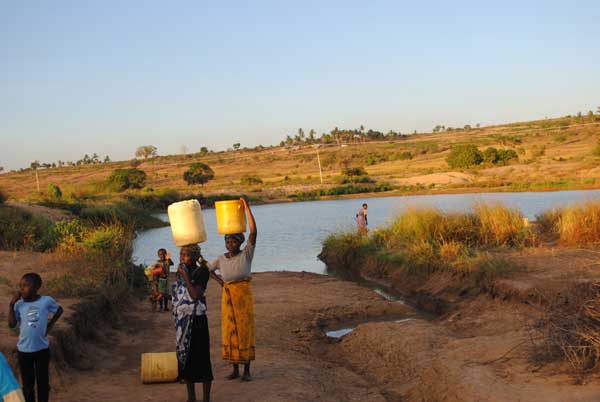Drought And The Women Of Mariakani In Mombasa
By Marianne de Nazareth
01 April, 2010
Countercurrents.org

As our car bumped along the long road to Mariakani village in rural Mombasa in Kenya, the picture we all wanted to click with our digital cameras was, of the Kenyan mothers carrying their little babies strapped to their backs. Most often besides the baby strapped to her back she had a heavy plastic container of water on her head. Not very far away, close to the villages were groups of men and boys, playing energetic games of football in open play grounds. It seemed like there was a very clear cut gender divide. Men and boys did not fetch water or help with the babies. That was woman’s work.
For several years in the recent past, Mombasa, Kenya has been reeling under terrible drought conditions due to Climate Change. Procurement of fresh water by the rural women was from dodgy sources and this caused a lot of illness and death by diarrhoea in children and babies. What we were witness to were women collecting water from a local village pond for their fresh water supplies in Mariakani. This limited access to water was not about dying of thirst only due to lack of fresh water, but had profound socio-economic implications as well. Here in Mariakani we could see women and girls who were responsible for collecting water, walking hours to haul enough water for their families. This probably left them with very little time for house hold tasks, getting an education and least of all income generation. So we saw a two fold problem in the village - a scarcity of fresh water and the implications of having to fetch that water on the women in the area.
According to the Secretariat of the Convention on Biological Diversity(CBD), Canada, “Water is unique amongst our natural resources because whilst it is renewable, it is not replaceable. We have various substitutes for energy sources and most commodities, but there is no substitute for water. Once it is gone or degraded through over use and pollution, it cannot be substituted.”
Archim Steiner, The Executive Director , UNEP, at the World Water Day celebrations on the 22nd March, 2010, in Nairobi, Kenya said, “It is what we have done to the water supplies of the world which is coming back to haunt us. Transforming waste water from a major health and environmental hazard into a clean, safe and economically attractive resource is emerging as a key challenge in the 21st century. It is a challenge which will intensify as the world undergoes rapid urbanization, industrialization, unless decisive action is taken. The new report released today called Sick Water says two million tons of waste estimated to equal two of more billion tons of waste water is being discharged daily into rivers and seas. 1.2 million children die of this and more than half the hospital beds have people suffering and dying from the drinking of polluted water, than all the violence in the world.”
His words need to be heard across the world, where we humans take fresh water supplies for granted. After all water that is fit to drink without risk of immediate or long term harm is fundamental to human well being. Without food we can survive for weeks, but without water we can die of dehydration in as little as two days.
“About 2.8 billion people which is more than 40% of the worlds population experience some sort of water scarcity. This is expected to worsen significantly in Sub Saharan Africa, South Asia and parts of South America and the Middle east,” according to the CBD.
At Mariakani we were witness to the International Water Association’s (IWA) Water Quality Monitoring programme which were taught to school children in the Kinagoni Primary School. This programme was meant to educate the village on the importance of water quality which was being used in the households. Testing of the turbidity of the water was carried out by facilitators who made the children handle the simple experiments. pH levels too were checked and the children were educated on how the prevention of pollution of their fresh water source was important for all round health. These were reliable field sampling tools which were being taught by IWA’s Water Quality Monitoring programme to check the quality of water they were using on a daily basis.
According to UNEP and the Pacific Institute, USA, “ new and improved legal and institutional frameworks to protect water quality are needed from the international level down to the watershed and community level. As a first step, laws on protecting and improving water quality should be adopted and adequately enforced. Model pollution policies should be disseminated more widely and guidelines should be developed for ecosystem water quality as they are for drinking water quality. A concerted global education and awareness building campaign around water quality issues is needed, with targeted regional and national campaigns that connect water quality to issues of cultural and historical importance.”
There are few areas on the planet that do not face serious water availability or management problems like the village of Mariakani in Kenya. But although water is a global issue, the problems and solutions are highly localized.
The writer travelled to Mariakani in Kenya on a field visit under the aegis of UNEP.


